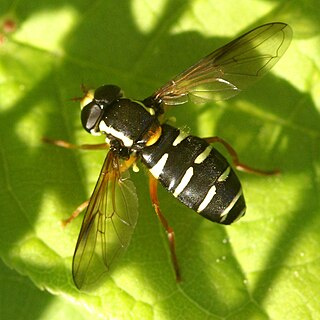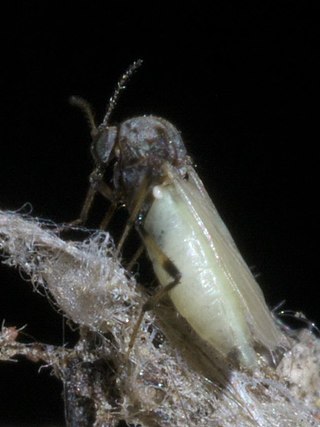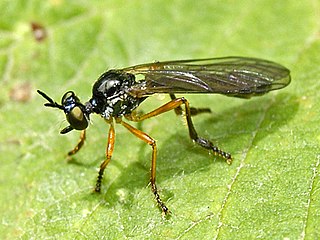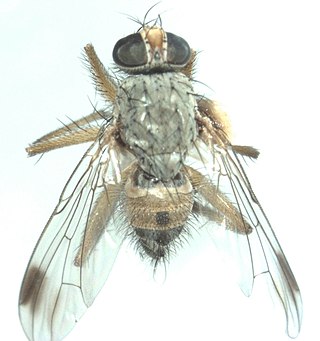
The black-tailed skimmer is a dragonfly belonging to the family Libellulidae.

Helophilus pendulus is a European hoverfly. Its scientific name means "dangling marsh-lover". It is a very common species in Britain, where it is the commonest Helophilus species. It is found throughout Europe from the Mediterranean to Scandinavia, westward to the Faroe Islands and Iceland, and through eastward through Russia from the Kola Peninsula south to Crimea and across Siberia to the Pacific Ocean.

Nipponopsalididae is a family of harvestmen with three described species in one genus, Nipponopsalis, which is found in East Asia.

Philhelius pedissequus is a species of hoverfly. Prior to 2018, it was known under the genus name Xanthogramma, a junior synonym.

Platycheirus immarginatus, the Comb-legged Sedgesitter, is a common species of hoverfly. It is found in parts of northern Europe and northern North America.
Carmenelectra is an extinct genus of fly belonging to the family Mythicomyiidae and containing a single species Carmenelectra shechisme.
Neal Luit Evenhuis is an American entomologist. He works at the Bishop Museum in Hawaii. Evenhuis has described over 500 species of insects since 1976, and is known both for his research and peculiar binomial names.

Philhelius citrofasciatus is a species of hoverfly found in grasslands from Ireland to western Siberia. The larvae live in Lasius ant colonies where they feed on the aphids tended by the ants. Prior to 2018, it was known under the genus name Xanthogramma, a junior synonym.

Pseudicius athleta is a species of jumping spider in the genus Pseudicius that is found in Kenya and Uganda. The spider was first defined in 2011 by Wanda Wesołowska. It lives communally, in individual nests which may contain either male or female spiders, which engage in complex courtship rituals. The spider is small, with an elongated cephalothorax between 1.8 and 2.2 mm long and an abdomen between 2.2 and 2.8 mm long. The carapace is dark brown with a black eye field but the abdomen has a pattern that differs between the male, which is marked by a brownish-fawn streak, and the female, which has a complex pattern consisting of a herring-bone pattern on the top, diagonal patches on the edge and two small round white spots on the bottom. Pseudicius athleta can be differentiated from other species in the genus by its copulatory organs. The male has a long thin embolus and characteristic tibial apophysis, which has three prongs. The female has narrow tube-like spermathecae. However, it is the swollen first leg, which is reminiscent of the large muscle of an athlete, as reflected in the species name, that most easily identifies the species.

Bezzia nobilis is a species of biting midges in the family Ceratopogonidae. It is widely considered one of the most common Bezzia species; it is found in Eurasian regions, all over the United States, Central America, and even into South American countries like Brazil. B. nobilis seem to prefer aquatic environments; they are commonly observed in stagnant water pools in Eurasia regions and marshes in the southern United States. Adults of this species are easily distinguished by their black and yellow striped legs. Pupae are recognized by their brown bodies, abdominal spines, and respiratory horns. B. nobilis larvae are distinguished by brown heads and white bodies. Little information is known on their life cycle or mating habits. B. nobilis is a predatory species. While some research suggests they mainly feed on larvae of other insect species, experiments suggest they prefer immobile, easy prey such as dead adult flies, bacteria, and protozoa.
Platycheirus confusus, the Confusing Sedgesitter, is a species of syrphid fly in the family Syrphidae.

Dioctria bicincta is a species of robber fly classified in the subfamily Dasypogoninae of the family Asilidae.

Euchariomyia is a monotypic genus of the subfamily Bombyliinae. The only species is Euchariomyia dives.
Sphegina (Asiosphegina) achaeta is a species of hoverfly in the family Syrphidae found in Myanmar. It's easily identified by the weak setae on abdominal tergite I. It's similar in appearance to S. adusta but easily differentiated upon closer examination. The male genitalia are similar to S. pollex and S. culex, though it can be distinguished by having an acute posterodorsal corner of the superior lobe and a broader surstylus; it differs further from S. pollex by lacking a sub-basal dorsal thumb-like lobe. The arrangement of bristles on tergite I is similar to S. japonica.
Sphegina (Asiosphegina) adusta is a species of hoverfly in the family Syrphidae found in Myanmar. It's easily identified by its large size, left side surstylus with a number of unusual lobes, and general dark-brown coloration. It's similar to S. atricolor and S. furva, but unlike these species it lacks a transverse crest at the base of the lobe located sinistrolaterally at the posterior margin of male sternite IV.
Sphegina cultrigera is a species of hoverfly in the family Syrphidae found in Kambaiti Pass, Myanmar, a montane forest with swampy areas and streams located 2000 meters above sea level.

Brachyopa caesariata, the Plain-winged Sapeater, is an uncommon species of syrphid fly. It has been observed in Canada, Alaska and northern United States. Hoverflies get their names from the ability to remain nearly motionless while in flight. The adults are also known as flower flies for they are commonly found around and on flowers, from which they get both energy-giving nectar and protein-rich pollen. Larvae for this genus are of the rat-tailed type. B.caesariata larvae have not been described.
Dirioxa pornia, commonly known as the island fly, is a species of fruit fly native to Australia.

Pygophora apicalis is a species of fly in the family Muscidae and subfamily Coenosiinae. It is native to Australia and has been introduced to New Zealand.











